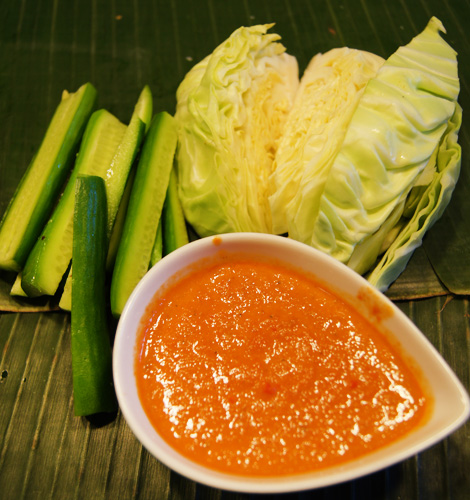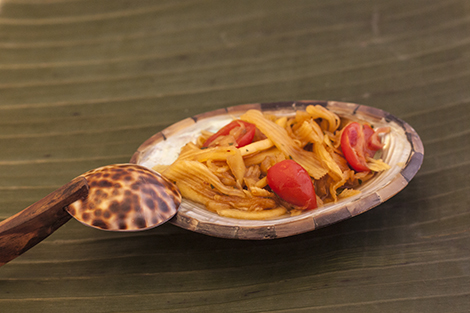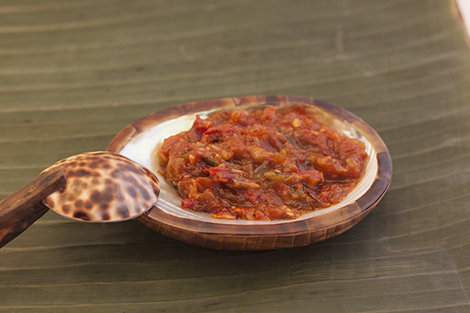Traditional from Indonesia : Sambal
The Food Of Hell From Indonesia
Famous as one of the best tropical countries, Indonesia provides tons of uniqueness and excitement. Its nature, culture, and art always bring millions of tourist each year. However, this time we are going to talk about one thing, Indonesia’s cuisine, in particular Sambal.
Sambal or sambel is infamous among tourist as the food of hell for its undeniable ability to make the consumer produces tears and sweat when eating. Produced using chili as its main ingredient, sambal is indeed taste extremely spicy.
Sambal is made by grinding ‘cabai’ or chili, along with several complements such as onion, cherry, tomato, ‘terasi’, sugar, and salt. The ingredients are grinded using traditional tool made usually from wood or plastic. The texture is smooth with a vibrant color of green and red, depending on which chili you use.
Infamous among tourists for its spiciness, many tourists avoid it. However, some of them are challenged and try to eat it. Those who dare to try usually will get stomach ache or turn very red and sweaty in the face. Though super spicy, locals eat it in almost daily basis as their main meal.
So these are some recipes to make indonesian sambal that I took from internet, try it at home!
So these are some recipes to make indonesian sambal that I took from internet, try it at home!
Bowld Mother Sambal
Flavor profile: Garlicky and pungent
Good with: Rice and noodle dishes, fried foods, ANYTHING.
Ingredients (makes 1 cup):
Good with: Rice and noodle dishes, fried foods, ANYTHING.
Ingredients (makes 1 cup):
- 1 cup of coarsely chopped Thai chiles / Red Jalapenos (you can substitute deseeded and diced red bell peppers to adjust the heat level)
- 1/2 cup of coarsely chopped garlic
- 3 tablespooncanola oil
- 1 tablespooncoarse salt
- 2 tablespoonwhite vinegar
- 1 glass jar
Warning: Wear kitchen gloves! You’ll deeply regret accidentally rubbing your eyes after cooking with spicy peppers.
While traditionally mashed with a mortar and pestle, chiles also can be put in a blender or food processor to achieve similar results. Just keep in mind that with the blender, we can’t usually get the relish-y texture that some prefer.
- Add canola oil to pan and turn the heat to medium.
- Once the oil is up to temperature, add chili mix and garlic to the pan and sauté until the chiles wilt and become softer in texture.
- Transfer chiles to the mortar and pestle or blender with a slotted spoon, leaving the oil in the pan for later.
- Add salt to the mortar and pestle or blender and mash or blend until desired consistency (we prefer a smooth but slightly chunky consistency).
- Add mixture back into pan with chili oil and add vinegar. Stir on medium heat for 1-2 minutes until the sambal has thickened a bit.
- Pour into a glass jar store for up to two months, or use it for other sambal recipes.
Pro Tip: Pour water and coffee grounds into your blender to rid it of any residual smell or spice.
Bowld Shrimp Paste Sambal (Sambal Terasi)
Flavor profile: Funky umami
Good with: Raw veggies, grilled meats, rice, soup
Good with: Raw veggies, grilled meats, rice, soup
Ingredients:
1 cup Bowld Mother Sambal
5 sautéed shallots
2 tablespoon of canola oil
½ tablespoon of terasi (shrimp paste)
1 medium size tomato, de-seeded & cubed
2 tablespoon of palm sugar, shaved
¼ teaspoon salt
Juice of ½ lime or 2 key limes
5 sautéed shallots
2 tablespoon of canola oil
½ tablespoon of terasi (shrimp paste)
1 medium size tomato, de-seeded & cubed
2 tablespoon of palm sugar, shaved
¼ teaspoon salt
Juice of ½ lime or 2 key limes
- Sweat the shallots in a pan with canola oil until translucent.
- Remove shallots from oil and fry the terasi in the oil for 2 minutes on low heat, breaking it up with your spatula.
- Add shallots, tomato, palm sugar, salt, and lime juice into the pan and sauté under medium heat for 1-2 mins.
- Transfer to blender for desired texture.
Bowld Mango Sambal
Flavor profile: Sweet and tangy, with a spicy finish
Good with: Fried or grilled seafood
Good with: Fried or grilled seafood
Ingredients:
1 tablespoon of Bowld Mother Sambal
2 green mangos, peeled & thinly shredded
5 shallots, thinly sliced
2 tablespoons of kecap manis (Indonesian sweet soy sauce)
Juice of ½ lime or 2 key limes
2 green mangos, peeled & thinly shredded
5 shallots, thinly sliced
2 tablespoons of kecap manis (Indonesian sweet soy sauce)
Juice of ½ lime or 2 key limes
Method:
- Combine ingredients into a bowl and stir
Bowld Sambal Belado
Flavor profile: Sweet and fragrant, with a relish-y texture
Good with: Eggs, spooned over fried wings, eggplant, or tossed with cooked vegetables
Good with: Eggs, spooned over fried wings, eggplant, or tossed with cooked vegetables
Ingredients:
1 tablespoon of Bowld Mother Sambal
1 red bell peppers, de-seeded and diced
2 medium size tomatoes, de-seeded & cubed
1 red onion, minced
2 tablespoons of palm sugar, shaved
¼ teaspoon of coarse salt
5 kaffir lime leaves (frozen is okay), thinly sliced
2 tablespoons of white vinegar
Juice of 2 key limes
1 tablespoon of canola oil
1 red bell peppers, de-seeded and diced
2 medium size tomatoes, de-seeded & cubed
1 red onion, minced
2 tablespoons of palm sugar, shaved
¼ teaspoon of coarse salt
5 kaffir lime leaves (frozen is okay), thinly sliced
2 tablespoons of white vinegar
Juice of 2 key limes
1 tablespoon of canola oil
Method:
- On medium-low heat, sweat onion in a pan with canola oil until translucent.
- Add the rest of ingredients to the pan and stir.
- Continue to stir 6-8 mins or until the bell peppers and tomatoes soften.
source : https://firstwefeast.com/eat/2015/01/how-to-make-diy-indonesian-sambal
Instructions!
- Analyze the text for its identification and general description in your blog! Highlight blue for the identification part, and green for general description part.
- Do you think all of the information in the text is true and correct? If not, find any incorrect information about the topic in the text! Write down below on what you think is wrong and give your correction!
- Develop the text by adding extra information. You can search in Google as source. Highlight the information that you add in the text using a light red color.
- 'Sambal or sambel is infamous among tourist...' → I don't think it's infamous among tourist because I have an uncle and he's British. The first thing he wanted me to buy was sambel, he said that lots of foreigner loved the spicy taste of sambel. They found it 'challenging'.
- 'Sambal is made by grinding ‘cabai’ or chili, along with several complements such as onion, cherry,...' → As far as I know, cherry is not one of the ingredient to make sambel.
- 'The ingredients are grinded using traditional tool made usually from wood or plastic.' → this statement is not wrong, but I see people prefer to grind it using electronic tool like blender rather than do it manually using 'ulekan'.
- Infamous among tourists for its spiciness, many tourists avoid it → I think most of them are coming to Indonesia to eat it, not to avoid it. Especially Asian tourists, most of their traditional food that are globally known have spicy taste, so the taste of sambel still match their tongue.
| U |
| Ulekan |
- ' ...locals eat it in almost daily basis as their main meal.' → Indonesian don't eat sambel as their main meal, it's more like additional to make the food tastier.





Komentar
Posting Komentar